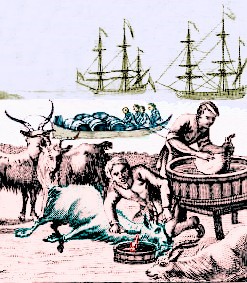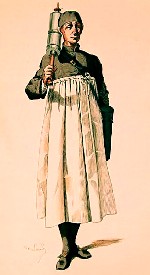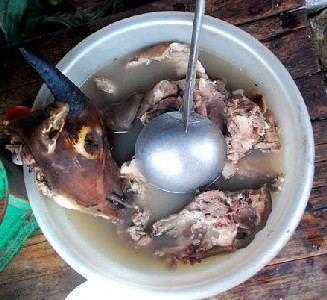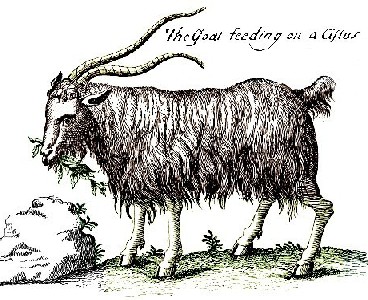
NexGoats in Medicine: 1 2 3 4 t>>
Goats in Medicine During the Golden Age of Piracy, Page 3
Goat Blood
"The [goat's] Blood is accounted alexipharmic [a cure for poison], deobstruent [able to remove obstructions]. proper in Dysenteries and calculated for resolving coagulated Blood, and dissolving the Stone. The Marrow is more acrid and dry, and consequently more efficacious, than that of other animals." (Robert James, Pharmacopœia universalis, p. 497)
As fantastic as it may seem to us today, the blood of animals was used as medicine during the golden age of piracy. Like fellow medicine author Robert James, Pierre Pomet suggested that the blood be administered internally. He thought that animal blood had different "Degrees of Volatility" which appears to refer to how long it acted in a patient's system. This imparted "different Virtues one from the other; so those [animal bloods] which have very volatile Salts, are usually reckon'd Cephalick

Author John Woodall
[useful in problems with the head] and Diaphoretick [able to cause sweat]; as the Viper, Human Skull, Hart's-horn, Goat's-Blood, Elk-Claw, because the Matter being heated in the Viscera, puts forth their Salts into the Brain, and by the Pores of the Body."1
Sea surgeon John Woodall had another idea, suggesting that animal blood be used externally on a patient with scurvy. "[W]here you can have it, a good bathe of the bloud of beasts, either cowes, horses, asses, goats, or sheeps bloud is exceeding good, namely to put [on] the legges of the patient, yea and his body too, if it may bee, into a tub made fitting, and the blood kept warme, part thereof being still kept hot on the fire, and renew therewith the bath still, as it cooleth with the warme blood, for some reasonable time, this restoreth and comforteth mightily the decayed spirits."2 Of course, the difficulty of procuring that much blood combined with the added challenge of keeping it warm as he recommends would make this cure rather challenging on a ship.
When obtaining goat's blood for medicinal purposes, Pomet recommends that the selected "Beast must be fed for some Time with aromatical Herbs, and such as are proper to break the Stone [calcinated stones in the urinary system of people], and must not be above four or five Years old."3
Robert James tells the surgeon that in "the beginning of Summer open some proper Artery of a middle aged Goat, and draw out a Quantity of Blood; which, being received in a clean Vessel, is to be dried either in the Heat of the Sun, or a slack Oven."4 While

Goat's Blood Collection, From
An Historical
Account of All the Voyages Round the World
Performed by
English Navigators, Vol I (1774)
powdering goat's blood would seem to potentially remove any healing properties period authors gave it, it would also have made it easier for a ship's surgeon to have on hand. If the key elements of animal blood were thought to be salts as Pomet explains, these would at least be retained through the evaporation of the liquid part of the blood.
Pomet gives different instructions for gathering the blood of the goat, although his are quite a bit more detailed than James' instructions.
Having cut its Throat, you are to reserve only the middle or second Blood, rejecting what comes out first and last. This you are to put into an earthen Vessel cover'd with a clean Cloth, to hinder Dust or Dirt from falling into it, and expose it to the Sun, or set it in the Shade to dry; and when it is well dried, it ought to be put into a Glass Phial to keep it for Use. They usually prepare the Blood of a Goat in the Month of July, because then the Herbs on which they feed are suppos'd to have their full Virtues. [Joannes Baptista] Van Helmont affirms, that if you hang the Goat by the Horns, and bending the hind Feet to the Sides of the Head; in this Posture cause his Testicles to be cut out, and dry the Blood that runs from the Wound, it will become as hard as Glass, and difficult to beat into Powder, and quite different from that taken from the Throat. 5
1 Pierre Pomet, The Compleate History of Druggs, 3rd Edition, Preface, p. 4; 2 John Woodall, the surgions mate, p. 193; 3 Pomet, p. 258; 4 Robert James, Pharmacopœia universalis, p. 627; 5 Pomet, ibid.
Goat Clysters
Clysters, or as we refer to them today - enemas - were often used as a purge in treating illnesses. When a patient was ill, the blame was often laid off 'bad humors.' The body was thought to contain four humors - blood, phlegm black and yellow bile. Illness suggested that these humors

Artist: Maurice Sands
The Apothecary Comes with
a
Syringe for Monsieur de
Pourceaugnac, from
Oeuvres Completes de
Moliere (1669)
needed to be balanced and bad humors must be purged from the body. The clyster was one way to do this, administered through the use of a large clyster syringe.
Sea physician Thomas Aubrey was a particular fan of the use of clysters containing goat's broth and he recommends them for several different illnesses.
Aubrey first mentions this cure for when called to assist another surgeon in treating a patient suffering from diarrhea. This occurred while he was "languishing under the Relicks of a dysenterick Fever. He was very much debilitated, and almost continually going to Stool: He had some Symptoms of a Fever towards Night; his Ordure was of an evil green and dark Colour; upon which followed, sometimes, a few Particles of dark livid Blood, and small Pellicles like Shavings of the Guts; and sometimes (perhaps twice a Day) a kind of tough Matter a little fetid, which corroded his Fundament as it came away"1.
The other surgeon had tried bleeding the patient and administering ipecacuanha twice, with no positive result. Aubrey explains, "I ordered him a Clyster, composed of a Pint of the Broth of a Goat’s Head, mixed with Balsam of Capavi [copaiba - a stimulant obtained from the trunk of several South American trees] and Venice Treacle [a complex herbal concoction - see the article on fluxes for more on this], of each half an Ounce, to be injected immediately, and repeated every Night, for three of four Days successively"2.
A goat's head broth enema was used by Aubrey while treating another fever. Sailor Joseph Booth,

Photographer: Travel Photographer
Goat's Head Broth
who had what Aubrey diagnosed as a 'putrid' fever, was "very ill with prodigious Pains, Lassitude and Heaviness all over his Body; his Pulse grew very low and weak, his Visage pale and wan, which was soon after succeeded by a violent intense Heat, a quick inordinate Pulse, great Thirst and Inquietude; his Tongue became very white, his Urine red, and his Appetite went from him, &c."3 (It does sound pretty putrid at that.)
To cure Booth, Aubrey bled him "12 ounces", purged him (made him vomit) using a rhubarb-based jalap. The day following, Aubrey gave Booth the purge again and followed it with "a Clyster made with a Quart of the Broth of a Goat’s Head, in which was boiled a few Flowers of Camomile, and a little Honey was added to it, and he took the following Bolus once in six Hours, for four several Times successively."4 Seven days later, the patient was cured! (Most like thanks to nature as much as any bleeding or clysters.) It is somewhat notable that this was a case where the patient was 'purged upwards' by forcing him to vomit, and then purged downwards using the goat's head clyster.

Photographer: Mauro Helpern
The Copaifera Langsdorfii, one of the trees from
which Copaiba is obtained
Apparently not wanting to stray too far from a good remedy, Aubrey recommended a goat-based enema for patients suffering from colic. Colic at this time was not the incessant crying of infants as we think if it today. It was used to refer to pains in the abdomen. As Aubrey explains, "Its Signs are great Pains in the Bowels, which range from one part to another, also Vomitings, Suppression of Urine, and other intolerable Accidents."5
His recommended cure for colic was bleeding, followed by "a Clyster made with {pound}j of the Broth of Goats Flesh, {ounce}j. of Honey, and {dram}v. of Bals Capayb. [copaiba balsam] [This will] relieve the Patient sooner, and better than any other thing you can make use of, after which, give him a gentle Purge, in order to cleanse the Folds of the Intestines and Stomach, and to prevent another Fit, or worse Accidents, which may otherwise (perhaps) spring from the Reliques of the Morbific Matter."6
1 Thomas Aubrey, The Sea-Surgeon or the Guinea Man’s Vadé Mecum., p. 85-6; 2 Aubrey, p. 86-7; 3 Aubrey, p. 30-1; 4 Aubrey, p. 32; 5 Aubrey, p. 96; 6 Aubrey, p. 97-8
Goat Ladanum/Labdanum
"The chief Commodity we sell which comes from these Goats, is a kind of Fat or Grease which is found sticking sticking to the Beards of these Animals, especially such of them as feed upon nothing but the Leaves of a certain Shrub, very common in the hot Countries, which the Botanists call Cistus Ledum". (Pierre Pomet, The Compleate History of Druggs, 3rd Edition, p. 257)

Photographer:Javier Martin
Cistus Ladanifer - A Type of Rockrose
Ladanum (or labdanum) is a sticky resin culled from the leaves and branches of the plants Cistus ladanifer (what Pomet calls Cistus Ledum) and Cistus creticus - two sub-species of rockrose. It apparently has a very fragrant odor, which wikipedia calls "rich, complex and tenacious", resembling ambergris.1 Like ambergris and many other pungent herbal extracts, labdanum was used during the golden age of piracy as a medicine. Unlike many of the other strong-smelling medicinals, ladanum was gathered from goats.
Pierre Pomet described the process of obtaining ladanum in great detail, explaining that it was gathered "with wooden Instruments, like Combs". Since it contained "Hair and other Filth", it was made into "Cakes of different Size and Weight". As Pomet explains, people in the areas where the goats at the rockrose plants "understood that there was a sweet pleasant Smell in this greasy matter and that when it was well purified, it would be considerably valued." So they melted the cakes of combed out matter and strained the result through cloth "to take out the Dross, as to give it a more fragrant Smell. Having thus refin'd it, they wrap it up in fine thin Bladders, as we have it brought us, and to which we give the Name of Liquid Labdanum, or Black Balsam."2
He advises his readers, "Chuse the bearded Labdanum, the most fragrant and cleanest you can get. The liquid Kind ought to be of a solid Consistance, of a fine Jet Black, sweet and pleasant to the Small, inclining to

The Goat Feeding on a Cistus, Taken from
The History of Druggs,
by Pierre Pomet, 3rd ed., p. 257
that of Ambergrease, which has given Occasion to some Merchants to sell liquid Labdanum for black Ambergrease. As to the twisted Sort, it ought to be rejected, as being full of nothing but Dirt and Sand."3 By 'twisted sort', Pomet is referring to a less expensive form of goat's beard labdanum imported into France and England, which he explains elsewhere as being the "worst of the liquid Labdanum."4
As for its use, Nicholas Culpeper explains that it is
thickning, heating & molifying, it opens the passage of the veins and keeps the hair from falling off; the use of it is usually external: being mixed with Wine, Myrrh, & oil of Myrtles, and applied like a plaister, it takes away filthy scars, and the deformity the Small pox leave behind them; being mixed with oil of Roses, and dropped into the Ears, it helps pains there being used as a pessary, provokes the terms, helps hardness or stiffness of the Womb: It is sometimes used inwardly in such Medicines as ease pains and help coughs: If you mix a little of it with old white wine and drink it, it both provokes Urine, and stops loosness or Fluxes.5
With such a reputation, it is surprising that it wasn't more widely recommended in the period sea-surgeon's books!
1 Labdanum, wikipedia, gathered 4/19/13; 2 Pierre Pomet, The Compleate History of Druggs, 3rd Edition, p. 258; 3 Pomet, p. 258; 4 Ibid.; 5 Nicholas Culpeper, Pharmacopœia Londinesis, p. 70

